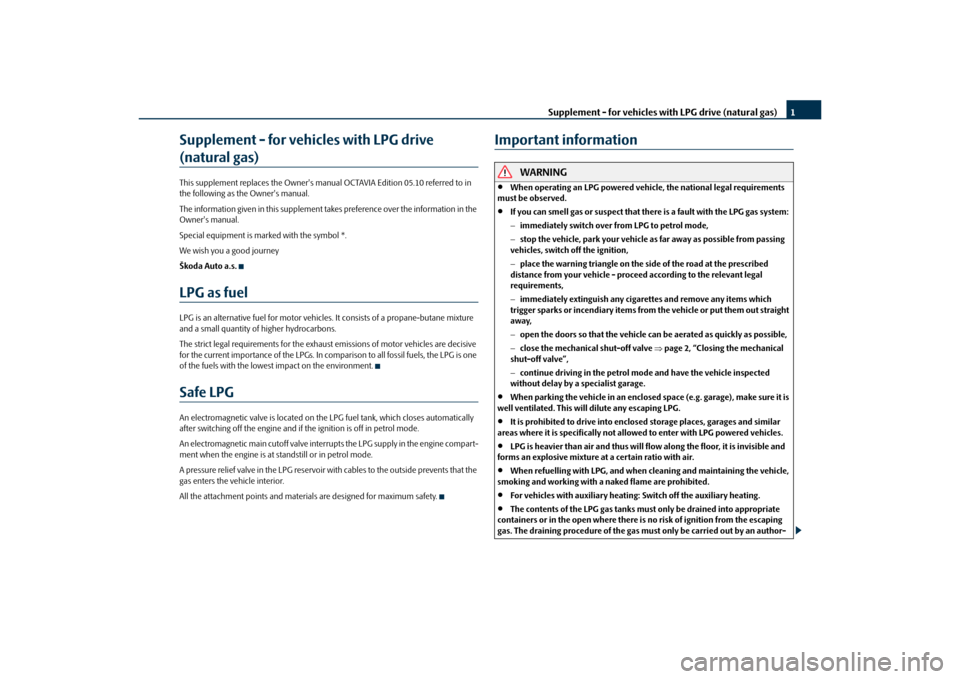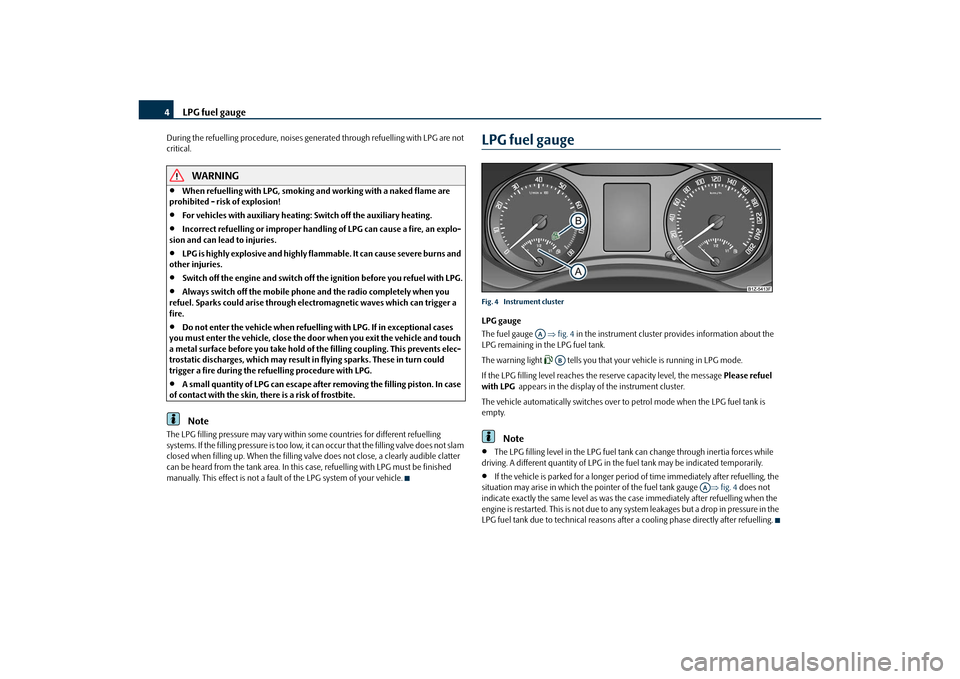2010 SKODA OCTAVIA ignition
[x] Cancel search: ignitionPage 2 of 10

Supplement - for vehicles with LPG drive (natural gas)1
Supplement - for vehicles with LPG drive (natural gas)This supplement replaces the Owner's manual OCTAVIA Edition 05.10 referred to in
the following as the Owner's manual.
The information given in this supplement takes preference over the information in the
Owner's manual.
Special equipment is marked with the symbol *.
We wish you a good journey
Škoda Auto a.s.LPG as fuelLPG is an alternative fuel for motor vehicles. It consists of a propane-butane mixture
and a small quantity of higher hydrocarbons.
The strict legal requirements for the exhaust emissions of motor vehicles are decisive
for the current importance of the LPGs. In comparison to all fossil fuels, the LPG is one
of the fuels with the lowest impact on the environment.Safe LPGAn electromagnetic valve is located on the LPG fuel tank, which closes automatically
after switching off the engine and if the ignition is off in petrol mode.
An electromagnetic main cutoff valve interr upts the LPG supply in the engine compart-
ment when the engine is at standstill or in petrol mode.
A pressure relief valve in the LPG reservoir with cables to the outside prevents that the
gas enters the vehicle interior.
All the attachment points and materi als are designed for maximum safety.
Important information
WARNING
•
When operating an LPG powered vehicl e, the national legal requirements
must be observed.
•
If you can smell gas or suspect that th ere is a fault with the LPG gas system:
− immediately switch over from LPG to petrol mode,
− stop the vehicle, park your vehicle as far away as possible from passing
vehicles, switch off the ignition,
− place the warning triangle on the si de of the road at the prescribed
distance from your vehicle - proceed according to the relevant legal
requirements,
− immediately extinguish any cigarettes and remove any items which
trigger sparks or incendia ry items from the vehicle or put them out straight
away,
− open the doors so that the vehicle can be aerated as quickly as possible,
− close the mechanic al shut-off valve page 2, “Closing the mechanical
shut-off valve”,
− continue driving in the petrol mode and have the vehicle inspected
without delay by a specialist garage.
•
When parking the vehicle in an enclosed space (e.g. garage), make sure it is
well ventilated. This will dilute any escaping LPG.
•
It is prohibited to drive into enclos ed storage places, garages and similar
areas where it is specifically not allo wed to enter with LPG powered vehicles.
•
LPG is heavier than air and thus will flow along the floor, it is invisible and
forms an explosive mixture at a certain ratio with air.
•
When refuelling with LPG, and when cleaning and maintaining the vehicle,
smoking and working with a naked flame are prohibited.
•
For vehicles with auxiliary heating: Switch off the auxiliary heating.
•
The contents of the LPG gas tanks must only be drained into appropriate
containers or in the open where there is no risk of ignition from the escaping
gas. The draining procedure of the gas mu st only be carried out by an author-
s5h8.8.book Page 1 Wednesday, October 27, 2010 11:20 AM
Page 5 of 10

LPG fuel gauge
4
During the refuelling procedure, noises ge nerated through refuelling with LPG are not
critical.
WARNING
•
When refuelling with LPG, smoking and working with a naked flame are
prohibited - risk of explosion!
•
For vehicles with auxiliary heating: Switch of f the auxiliary heating.
•
Incorrect refuelling or improper handling of LPG can cause a fire, an explo-
sion and can lead to injuries.
•
LPG is highly explosive and highly fla mmable. It can cause severe burns and
other injuries.
•
Switch off the engine and switch off the ignition before you refuel with LPG.
•
Always switch off the mobile phone and the radio completely when you
refuel. Sparks could arise through electromagnetic waves which can trigger a
fire.
•
Do not enter the vehicle when refuelling with LPG. If in exceptional cases
you must enter the vehicle, close the do or when you exit the vehicle and touch
a metal surface before you take hold of the filling coupling. This prevents elec-
trostatic discharges, which may result in flying sparks. These in turn could
trigger a fire during the refuelling procedure with LPG.
•
A small quantity of LPG can escape after removing the filling piston. In case
of contact with the skin, there is a risk of frostbite.Note
The LPG filling pressure may vary within some countries for different refuelling
systems. If the filling pressure is too low, it can occur that the filling valve does not slam
closed when filling up. When the filling valv e does not close, a clearly audible clatter
can be heard from the tank area. In this ca se, refuelling with LPG must be finished
manually. This effect is not a fault of the LPG system of your vehicle.
LPG fuel gauge Fig. 4 Instrument clusterLPG gauge
The fuel gauge fig. 4 in the instrument cluster provides information about the
LPG remaining in the LPG fuel tank.
The warning light
tells you that your vehicle is running in LPG mode.
If the LPG filling level reaches the reserve capacity level, the message Please refuel
with LPG appears in the display of the instrument cluster.
The vehicle automatically switches over to petrol mode when the LPG fuel tank is
empty.
Note
•
The LPG filling level in the LPG fuel tank can change through inertia forces while
driving. A different quantity of LPG in the fuel tank may be indicated temporarily.
•
If the vehicle is parked for a longer period of time immediately after refuelling, the
situation may arise in which the pointer of the fuel tank gauge fig. 4 does not
indicate exactly the same level as was the case immediately after refuelling when the
engine is restarted. This is not due to any system leakages but a drop in pressure in the
LPG fuel tank due to technical reasons after a cooling phase directly after refuelling.
AA
AB
AA
s5h8.8.book Page 4 Wednesda y, October 27, 2010 11:20 AM